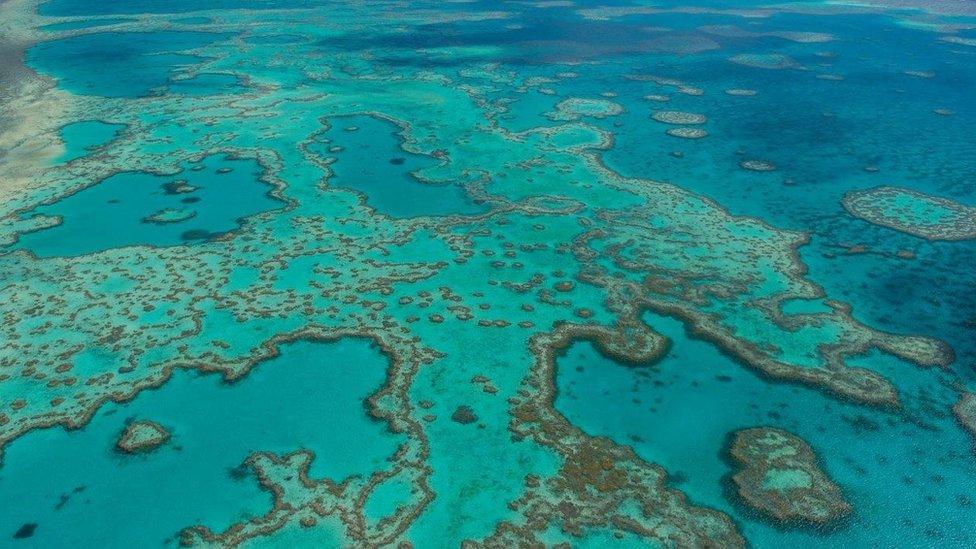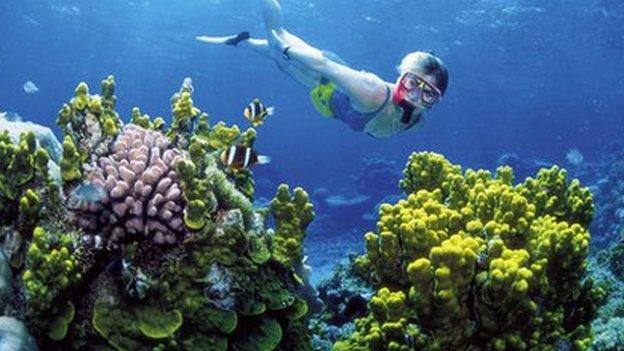Hidden viruses may threaten Australia's Great Barrier Reef
- Published

Symbiodinium, seen here under a microscope, is a photosynthetic algae that has a symbiotic relationship with healthy coral
Australian scientists suspect a trio of viruses infecting algae from the Great Barrier Reef may aggravate coral bleaching.
Healthy corals rely on a symbiotic relationship with a photosynthetic algae known as Symbiodinium.
These single-celled organisms live in coral tissue and provide them with up to 90% of their nutrients.
But under stressful conditions, such as elevated water temperatures, this relationship breaks down.
The algae may stop photosynthesising or else corals can expel them into the sea. This results in bleaching, which can prove fatal to the coral.
Now researchers from the Australian Institute of Marine Science (AIMS) have discovered three distinct viruses attacking Symbiodinium cells, living in a lab culture established from samples collected along the Great Barrier Reef in northern Queensland.
"In the cultures that we have... there seems to be this ongoing, persistent viral infection," says Dr Karen Weynberg, a marine biologist from AIMS who led the research.
"It seems like Symbiodinium is really under attack, quite heavily, from three different types of viruses."
Weynberg, who imaged and sequenced the genomes of the viruses, says there is a "strong possibility" they are having detrimental effects on the algae's ability to photosynthesise and, as a result, could be contributing to coral bleaching.
Her findings provide new insight into the currently unclear impact of viruses on the health of coral reefs, and may have implications for scientists who use algae cultures to study corals.
She will present her results this week at the 2016 Ocean Sciences Meeting in New Orleans.

Australian researchers suspect viruses may contribute to the bleaching of coral
Finding the viruses
Viruses are abundant in our oceans. It is estimated there are up to 10m different viruses in a single teaspoon of seawater.
Previous research has shown that exposing Symbiodinium cultures to stress, either in the form of ultraviolet light or elevated temperatures, can cause "latent viruses" to appear.
"I initially set out to repeat those experiments," Weynberg says. "But what I actually found was that, regardless of exposing the Symbiodinium in culture to stressors, the culture already had this persistent, prevalent infection going on… The viruses were actively replicating."
"This was completely unexpected. I was seeing viruses in my stress-free controls."
Of the three different viruses, Weynberg says she is particularly intrigued by a destructive filament-shaped virus, which replicates inside the nucleus of the cell.
"I don't think I've seen anything like them before," she says.
"Those filamentous viruses start taking over the entire cell. By the end you don't see any chloroplasts, you don't see any mitochondria. Eventually all the components of the cells are seen to degrade, and of course that's doom for that particular cell. It's not too rosy a picture."
Are they present in nature?
While the viruses are almost certainly present in corals, Dr Weynberg says they may not be infecting algae as aggressively in the wild.
Algae grown in culture is under stress because it has not had the opportunity to form a symbiotic association with coral, she explains, and this bond could keep the viruses at bay.
She says the next step is to capture and analyse expelled Symbiodinium cells immediately after a bleaching event to see if any of the same viruses can be identified.
"[We also need to] quantify what proportion of cells are going to be under attack because quite often in a viral infection a host can become resistant", she says.
"Coral reef virology is not even in its infancy, it's practically embryonic, so with all these questions we need to go out and rigorously test our hypotheses."

Coral bleaching is a significant threat to Australia's Great Barrier Reef, one of the country's major tourist attractions
"This is really an important and revealing observation," says Dr Rebecca Vega Thurber, a marine diseases expert from Oregon State University, who was not involved in the study. "The viruses have probably always been there and we've just never detected them."
In 2011, Vega Thurber was serendipitously on the Great Barrier Reef during a mass bleaching event. She collected samples from the coral and discovered viruses were two to four times more abundant than previously documented.
"This was the first time that viral outbreaks had been associated with bleaching events in the wild," she told the BBC.
While not the main driver of coral bleaching, the viruses are likely to be involved in the mechanism that results in the breakdown of the symbiotic partnership, she says.
But microbiologist Dr Ian Hewson from Cornell University in the US says it's "too early to say whether these viruses have any role at all in bleaching".
"It is encouraging that the viruses cause damage to the cells in culture and that may indicate some role in their mortality," he says.
"But it's difficult to put this in context of the stability of symbiosis. It might be "more of a pest than anything, as you lose your lab rats, so to speak", he adds.
- Published28 October 2014

- Published28 October 2014
